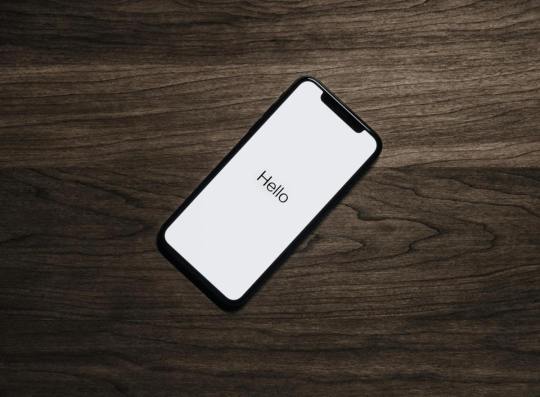#Two-Factor Authentication
Explore tagged Tumblr posts
Text
#Data Protection Act#Privacy Online#Online Privacy#Personal Data Protection#Data Breaches#Privacy Rights#Online Security#Protecting Personal Information#Secure Browsing#Encryption#VPN#HTTPS#Strong Passwords#Two-Factor Authentication#Privacy Settings#Safe Online Communication
2 notes
·
View notes
Text
How to Set Up 2FA on All Your Devices in 2025
As we move further into the digital age, securing your online accounts has never been more critical. One of the most effective ways to protect your accounts from unauthorized access is by using Two-Factor Authentication (2FA). This extra layer of security adds a second step to your usual login process, making it harder for hackers to gain access to your sensitive data. In 2025, setting up 2FA is…
0 notes
Text
How to Protect Your WordPress Database from Cyber Threats
Introduction Your WordPress database is the backbone of your website, storing critical data such as user information, posts, pages, comments, and settings. If compromised, your site could suffer data breaches, downtime, or even total loss of content. Cyber threats like SQL injections, brute force attacks, malware infections, and unauthorized access can put your database at serious…
#brute force attack protection#database backup#database security#limit login attempts#malware scanning#optimize wordpress database#secure wp-config#SQL injection prevention#two-factor authentication#web application firewall#wordpress cybersecurity#wordpress database protection#wordpress firewall#wordpress security
0 notes
Text
Tech News - ನಿಮ್ಮ ಸ್ಮಾರ್ಟ್ ಪೋನ್ ಹ್ಯಾಕ್ ಆಗೋದನ್ನು ಹೇಗೆ ತಡೆಯಬಹುದು? ಈ ಸಿಂಪಲ್ ಟಿಪ್ಸ್ ಫಾಲೋ ಮಾಡಿ….!
Tech News : ಇಂದಿನ ಡಿಜಿಟಲ್ ಜಗತ್ತಿನಲ್ಲಿ ಸ್ಮಾರ್ಟ್ ಪೋನ್ ನಮ್ಮ ಬದುಕಿನ ಅವಿಭಾಜ್ಯ ಅಂಗವಾಗಿದೆ. ಪರ್ಸನಲ್ ಮಾಹಿತಿ, ಬ್ಯಾಂಕ್ ಡೀಟೇಲ್ಸ್, ಪಾಸ್ವರ್ಡ್, ಫೋಟೋಗಳು, ಮತ್ತು ವಿಡಿಯೋಗಳನ್ನು ನಾವು ಸ್ಮಾರ್ಟ್ ಪೋನ್ ನಲ್ಲಿ ಸೇವ್ ಮಾಡುತ್ತೇವೆ. ಆದರೆ, ಸ್ಮಾರ್ಟ್ ಪೋನ್ ��ಳು ಹ್ಯಾಕರ್ಗಳ ಪ್ರಮುಖ ಟಾರ್ಗೆಟ್ ಆಗಿವೆ. ಸ್ಮಾರ್ಟ್ ಪೋನ್ ಹ್ಯಾಕ್ ಆದ್ರೆ ನಿಮ್ಮ ಪರ್ಸನಲ್ ಮಾಹಿತಿ ಕಳ್ಳತನವಾಗಬಹುದು ಮತ್ತು ಹಣಕಾಸು ನಷ್ಟವಾಗುವ ಸಾಧ್ಯತೆ ಇದೆ. ಆದರೆ ಕೆಲವೊಂದು ಸುಲಭ ಟಿಪ್ಸ್ಗಳನ್ನು ಪಾಲಿಸಿದರೆ…

View On WordPress
#Android Security Tips#How to Secure Smartphone#Mobile Hacking Prevention#Protect Smartphone from Hackers#Security Tips#Smartphone Hack Safety#Smartphone Privacy Protection#Strong Password Protection#Tech News#Two-Factor Authentication
0 notes
Text
#SMS verification#SMS verification code#two-factor authentication#OTP#online security#cyber threats#user authentication#secure login#SMS security#digital interactions
0 notes
Text
FBI Warns Against SMS Two-Factor Authentication Risks
The FBI, along with the Cybersecurity and Infrastructure Security Agency (CISA), has issued a warning against using two-factor authentication (2FA) via SMS text messages due to several significant security concerns: Security Vulnerabilities Interception of Messages: SMS messages are transmitted in clear text, making them susceptible to interception by attackers[9]. This vulnerability allows…
0 notes
Text
Stay Safe Online and In Life: Key Strategies for Digital Protection During the Holidays and Always
In today���s connected world, computer and phone security are very important. As cyber threats and data breaches increase, it’s vital to stay informed and take steps to protect your digital life. Here, we share insights from tech journalist Naomi Brockwell and investigative reporter Byron Tau to help you with digital security. Naomi Brockwell: Empowering Privacy in the Digital Age Naomi Brockwell…
#2FA#Bryon Tau#Digital Age#how to secure your privacy#how you are being tracked#Naomi Brockwell#Online safety#oversharing on Social Media#Strong password#two-factor authentication
0 notes
Text
Life Can Change Any Moment
BeerBiceps aka Ranveer Allahbadia YouTube Channels Getting Hacked: A Deep Dive into the Incident and Its Implications In the fast-paced world of digital media, creators are often vulnerable to cyberattacks that can derail years of hard work and dedication. One such incident that shocked the Indian YouTube community was when popular content creator Ranveer Allahbadia, also known as BeerBiceps,…
#BeerBiceps#Content creator security#Cyberattacks on influencers#Cybersecurity#Digital content creators#Digital content protection#Hacking incidents#Online privacy#Phishing attacks#Protecting YouTube accounts#Ranveer Allahbadia#Social engineering attacks#Social media security#Two-factor authentication#YouTube channel hacked#YouTube channel recovery#YouTube hacking incident
0 notes
Text
Online Scams Warning: The Importance of Using Two-Factor Authentication

In today's digital world, the convenience of the internet comes with certain risks. Scammers now use sophisticated online methods to steal personal information, money, and identities. Understanding these threats is crucial to safeguarding yourself against potential losses. This article provides an online scam warning and explores essential security measures, including two-factor and multi-factor authentication and the importance of cyber threat intelligence.
Understanding the Threat: Online Scams Warning
Online scams try to get victims' passwords, credit card numbers, and social security numbers. These frauds include phishing emails, fake websites, and social engineering. Unfortunately, as technology advances, so do the methods used by scammers. According to reports, online frauds are rising, affecting millions of individuals annually. The financial and emotional toll of these scams can be devastating, making it more important than ever to heed online scam warnings and take proactive steps to protect yourself.
Common Types of Online Scams
Phishing Attacks: Phishing is a prevalent online scam where attackers send fake emails or messages. These messages often connect to bogus websites that steal login credentials or personal information.
Fake Online Stores: Scammers create bogus web stores that sell popular products cheaply. These sites gather payment information without delivering goods.
Social Engineering: Social engineering manipulates people into disclosing confidential information. Scammers pose as reputable people or companies in phone calls, emails, or in-person interactions.
Tech Support Scams: In these scams, fraudsters pretend to be tech support representatives from well-known companies like Microsoft or Apple. They pretend your computer has a virus and offer to remedy it for a cost, installing malware or stealing your data.
Strengthening Your Security with Two-Factor Authentication
Two-factor authentication (2FA) is one of the best techniques for securing online accounts. By requiring two forms of verification, it significantly reduces the chances of a scammer gaining access to your personal information, even if they have your password.
What is Two-Factor Authentication?
Two-factor authentication requires two types of identification to authenticate identity. This usually requires a password and a smartphone or security token. Even if cybercriminals obtain your password, they need the second factor to access your account.
How to Enable Two-Factor Authentication
Check Your Accounts: Many online services, including social media, email, and financial platforms, offer two-factor authentication as an option. Check your account security settings for 2FA.
Set Up Two-Factor Authentication: Follow the service's instructions to enable two-factor authentication. This usually requires connecting your account to a mobile device or using Google Authenticator.
Use 2FA Consistently: Once 2FA is enabled, make it a habit to use it every time you log in to your accounts. While it may add an extra step, the enhanced security is worth the effort.
Enhancing Protection with Multi-Factor Authentication

While two-factor authentication is vital, multi-factor authentication (MFA) takes protection further. Multi-factor authentication adds security to online accounts by verifying users with two or more independent factors.
The Importance of Multi-Factor Authentication
Multi-factor authentication provides additional security by combining multiple types of verification, such as something you know (password), something you have (security token), and something you are (biometric data like fingerprints). This multi-layered method makes it challenging for scammers to breach your protection, even if they compromise one factor.
Implementing Multi-Factor Authentication
Choose the Right MFA Methods: Depending on the service, you may have several options for multi-factor authentication, including SMS codes, email verification, security tokens, and biometric verification. Select the most suitable methods.
Enable MFA on All Sensitive Accounts: Ensure that multi-factor authentication is enabled on all accounts that store sensitive information, such as banking, healthcare, and email accounts.
Regularly Review and Update Your MFA Settings: Technology and cyber threats are evolving rapidly. Periodically review your multi-factor authentication settings and update them to maintain maximum security.
Staying Informed with Cyber Threat Intelligence
Cyber threat intelligence collects, analyses, and comprehends cyber threats. By staying current on scams and cyber risks, you can protect yourself and your data.
How Cyber Threat Intelligence Can Help
Cyber threat intelligence involves monitoring various sources of information, including open-source intelligence, social media, and specialised cybersecurity platforms. This information is then analysed to identify patterns and emerging threats. By staying updated with cyber threat intelligence, you can recognise potential dangers and adjust your security practices accordingly.
Applying Cyber Threat Intelligence in Daily Life
Stay Informed: Regularly read cybersecurity news, blogs, and reports to stay informed about the latest online scams and threats.
Use Cyber Threat Intelligence Tools: Consider using tools and services that provide real-time cyber threat intelligence, alerting you to potential risks as they arise.
Adapt Your Security Practices: Use the insights from cyber threat intelligence to improve your security practices. This might include changing passwords frequently, enabling new security features, or avoiding certain websites or services.
Conclusion
In today's increasingly connected world, the threat of online scams is ever-present. By heeding this online scam warning and taking proactive steps, such as enabling two-factor and multi-factor authentication, you can significantly reduce your risk of falling victim to these scams. Additionally, staying informed with cyber threat intelligence will help you stay ahead of emerging threats. Remember, the best defence against online scams combines awareness, strong security measures, and continuous vigilance. Protect yourself and your information by implementing these essential security practices today.
#Cyber Threat Intelligence#Multi-factor authentication#Two-Factor Authentication#Online Scams Warning
0 notes
Text
1 note
·
View note
Text
How to Set Up an Encrypted Email System
In today’s digital age, keeping your emails secure is crucial. Whether you’re dealing with sensitive business information or simply want to protect your personal communications, setting up an encrypted email system is a great step toward safeguarding your privacy. Here’s a simple guide to help you set up an encrypted email system. 1. Choose an Encrypted Email Provider Start by selecting an…
#email encryption tools#email security#encrypted attachments#encrypted email#Two-factor authentication
0 notes
Text
Essential WordPress Security Tips to Protect Your Website
[et_pb_section fb_built=”1″ _builder_version=”4.27.4″ _module_preset=”default” global_colors_info=”{}”][et_pb_row _builder_version=”4.27.4″ _module_preset=”default” global_colors_info=”{}”][et_pb_column type=”4_4″ _builder_version=”4.27.4″ _module_preset=”default” global_colors_info=”{}”][et_pb_text _builder_version=”4.27.4″ _module_preset=”default” hover_enabled=”0″ global_colors_info=”{}”…
#brute force attack prevention#disable xml-rpc#firewall for wordpress#limit login attempts#malware protection#protect wordpress website#secure wordpress hosting#secure wp-config file#SSL encryption#two-factor authentication#wordpress backup plugins#wordpress security#wordpress security best practices#wordpress security plugins#wordpress security tips
0 notes
Text
Items Returned
At long last, I have been restored to my property. Fourteen months ago, my mobile phone, personal computer, and other effects were removed from my home. What followed was a massive headache as I quickly realized that I could not access the majority of my accounts without the two-factor authenticator (2FA) app on my phone. My bank, primary email account, and all the financial offers I had done…

View On WordPress
1 note
·
View note
Text
Here's a reminder that you shouldn't use SMS text-based two-factor authentication.
App-based 2FA is far more secure, and it's instant too. If you're on a site that supports passkeys, those are even better!
[tumblr] offers both app-based and SMS text-based 2FA. If you're still on SMS, click the edit pencil icon next to "Two-factor authentication" in your Account Settings to switch on "Generate code via authenticator app" and switch off "Send code via SMS." And don't forget to save your backup codes!
If you don't have a smartphone that supports authenticator apps, SMS text-based 2FA is better than nothing, but do make that switch as soon as you can.
1 note
·
View note
Text
LinkedIn Hacker Mayhem
Automated Security Challenges – Photo Credit Gizmodo Should You Panic or Stay Calm? It could just be me but I doubt it. I’ve certainly had my share of attempts to attack my accounts including the SIM Jacking I documented (3 Minutes to Financial Ruin). But since the vast majority of these attacks are automated with the perpetrators using tools that essentially automate the tasks of attacking…

View On WordPress
#2FA#account protection#Cybersecurity#data breach#Hacking#Healthcare Security#LinkedIn#login alerts#Password Managers#password security#Passwords#phishing#secure#Security#social media security#two-factor authentication
0 notes
Text
Guard Against Financial Frauds as Data Leakage Becomes Rampant: Insights from RBI Officials
In an era where digital transactions and online banking have become the norm, safeguarding financial information has never been more critical. The Reserve Bank of India (RBI) officials recently highlighted the increasing threats of financial fraud due to rampant data leakage. This blog post delves into the nuances of this pressing issue and offers strategies to protect your financial data. The…

View On WordPress
#Cyber-attacks#Cybersecurity#Data leakage#Digital transactions#Encryption methods#Financial data protection#Financial fraud#financial institutions#Identity theft#Incident response plan#Phishing scams#RBI officials#Security audits#Two-factor authentication#Vulnerability assessments
0 notes